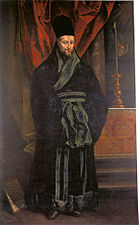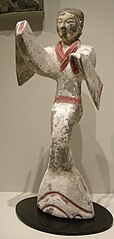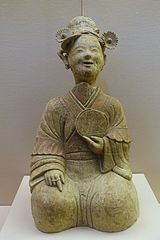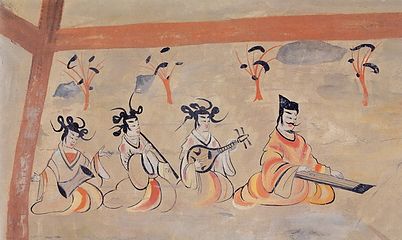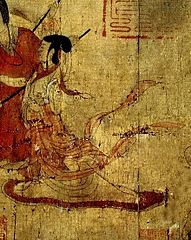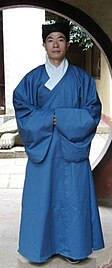Hanfu
You can help expand this article with text translated from the corresponding article in Chinese. (May 2015) Click [show] for important translation instructions.
|
This article has multiple issues. Please help improve it or discuss these issues on the talk page. (Learn how and when to remove these messages)
|
| Hanfu | |||||||||||||||||
|---|---|---|---|---|---|---|---|---|---|---|---|---|---|---|---|---|---|
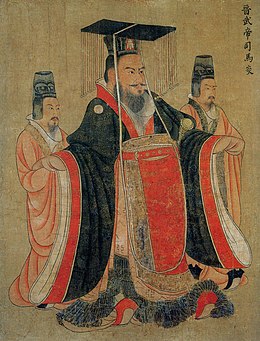 The mianfu of Emperor Wu of Jin dynasty, 7th-century painting by court artist Yan Liben | |||||||||||||||||
| Traditional Chinese | 漢服 | ||||||||||||||||
| Hanyu Pinyin | |||||||||||||||||
| Literal meaning | Han clothing | ||||||||||||||||
| |||||||||||||||||
Hanfu (Chinese: 漢服; pinyin: ; lit. 'Han clothing') is one of the historical/traditional clothing of the Han people.[1][2][3] The term Hanfu was originally recorded by the Book of Han, which refers to the Han dynasty's dresses: "then many came to the Court to pay homage and were delighted at the clothing style of the Han Dynasty."[4]
Han Chinese clothing is influential to the clothing of East Asia such as the Japanese kimono and Korean hanbok.[3]
Term and modern usage
Some research claim that historical records in Tang, Song and Ming dynasties also used this term "Hanfu" to refer the traditional dress of Han people,[5][6][7][8] yet scholarly research indicates that the modern definition of "Hanfu" was created on Baidu Baike and other Chinese websites by internet users, and the various styles of clothing during the Tang, Song, and Ming dynasties were referred to by their own names during their respective time periods.[9][10][11]
According to Zhang Xian (張跣), a professor of China Youth University of Political Studies, the modern definition of "Hanfu" is a problematic concept publicized by advocates of Hanfu movement. These advocates are mostly students, who created a non-academic, non-official standard of Hanfu that refers to the historical dress of the Han Chinese before the Qing dynasty and published it on Baidu Baike.[10]
Lecturer of Macquarie University Kevin Carrico pointed out that: "in reality, [modern] hanfu is an invented style of dress that features broad sleeves, flowing robes, belted waists and vibrant colours. Its modern-day proponents claim it was the invention of the mythical Yellow Emperor and was worn for millennia by the Chinese people... Han Clothing made the transition from a fantastic invented tradition to a distant image on a screen to a physical reality in the streets of China, in which one could wrap and recognise oneself."[11]
During an interview, an advocate of Hanfu movement admitted that: "The word 'Hanfu' is not included in the Contemporary Chinese Dictionary. The [current] definition of 'Hanfu' was, in fact, created by internet users."[12]
History

From the beginning of its history, Han clothing (especially in elite circles) was inseparable from silk, supposedly discovered by the Yellow Emperor's consort, Leizu. The Shang Dynasty (c. 1600 BC – 1000 BC), developed the rudiments of Hanfu; it consisted of a yi, a narrow-cuffed, knee-length tunic tied with a sash, and a narrow, ankle-length skirt, called chang, worn with a bixi, a length of fabric that reached the knees. Vivid primary colors and green were used, due to the degree of technology at the time.

The dynasty to follow the Shang, the Western Zhou Dynasty, established a strict hierarchical society that used clothing as a status meridian, and inevitably, the height of one’s rank influenced the ornateness of a costume. Such markers included the length of a skirt, the wideness of a sleeve and the degree of ornamentation. In addition to these class-oriented developments, Han Chinese clothing became looser, with the introduction of wide sleeves and jade decorations hung from the sash which served to keep the yi closed. The yi was essentially wrapped over, in a style known as jiaoling youren, or wrapping the right side over before the left, because of the initially greater challenge to the right-handed wearer (people of Zhongyuan discouraged left-handedness like many other historical cultures, considering it unnatural, barbarian, uncivilized, and unfortunate).
Several styles
Garments
The style of historical Han clothing can be summarized as containing garment elements that are arranged in distinctive and sometimes specific ways. This is different from the traditional garment of other ethnic groups in China, most notably the Manchu-influenced clothes, the qipao, which is popularly assumed to be the de facto traditional Han Chinese garb. A comparison of the two styles can be seen as the following provides[original research?]:
| Component | Han | Manchu |
|---|---|---|
| Upper Garment | Consist of "yi" (衣), which have loose lapels and are open | Consist of "pao" (袍), which have secured lapels around the neck and no front openings |
| Lower Garment | Consist of skirts called "chang" (裳) | Consist of pants or trousers called "ku" (褲) |
| Collars | Generally, diagonally crossing each other, with the left crossing over the right | Parallel vertical collars with parallel diagonal lapels, which overlap |
| Sleeves | Long and loose | Narrow and tight |
| Buttons | Sparingly used and concealed inside the garment | Numerous and prominently displayed |
| Fittings | Belts and sashes are used to close, secure, and fit the garments around the waist | Flat ornate buttoning systems are typically used to secure the collar and fit the garment around the neck and upper torso |
A complete Hanfu garment is assembled from several pieces of clothing into an attire:
- Yi (衣): Any open cross-collar garment, and worn by both sexes
- Pao (袍): Any closed full-body garment, worn only by men in Hanfu
- Ru (襦): Open cross-collar shirt
- Shan (衫): Open cross-collar shirt or jacket that is worn over the yi
- Qun (裙) or chang (裳): Skirt for women and men
- Ku (褲): Trousers or pants
Hats, headwear and hairstyles



On top of the garments, hats (for men) or hairpieces (for women) may be worn. One can often tell the profession or social rank of someone by what they wear on their heads. The typical types of male headwear are called jin (巾) for soft caps, mao (帽) for stiff hats and guan (冠) for formal headdress. Officials and academics have a separate set of hats, typically the putou (幞頭), the wushamao (烏紗帽), the si-fang pingding jin (四方平定巾; or simply, fangjin: 方巾) and the Zhuangzi jin (莊子巾). A typical hairpiece for women is the ji (笄) but there are more elaborate hairpieces.
In addition, managing hair was also a crucial part of ancient Han people's daily life. Commonly, males and females would stop cutting their hair once they reached adulthood. This was marked by the Chinese coming of age ceremony Guan Li, usually performed between ages 15 to 20. They allowed their hair to grow long naturally until death, including facial hair. This was due to Confucius' teaching "身體髮膚,受諸父母,不敢毀傷,孝之始也" - which can be roughly translated as 'My body, hair and skin are given by my father and mother, I dare not damage any of them, as this is the least I can do to honor and respect my parents'. In fact, cutting one's hair off in ancient China was considered a legal punishment called '髡', designed to humiliate criminals, as well as tattooing '黥', since regular people wouldn't have tattoos on their skin due to the same teaching.
Children were exempt from the above commandment; they could cut their hair short, make different kinds of knots or braids, or simply just let them hang without any care. However, once they entered adulthood, every male was obliged to tie his long hair into a bun called ji (髻) either on or behind his head and always cover the bun up with different kinds of headdresses (except Buddhist monks, who would always keep their heads completely shaved to show that they're "cut off from the earthly bonds of the mortal world"; and Taoist monks, who would usually just use hair sticks called '簪' (zān) to hold the buns in place without concealing them). Thus the 'disheveled hair', a common but erring depiction of ancient Chinese male figures seen in most modern Chinese period dramas or movies with hair (excluding facial hair) hanging down from both sides and/or in the back are historically inaccurate. Females on the other hand, had more choices in terms of decorating their hair as adults. They could still arrange their hair into as various kinds of hairstyles as they pleased. There were different fashions for women in various dynastic periods.
Such strict "no-cutting" hair tradition was implemented all throughout Han Chinese history since Confucius' time up until the end of Ming Dynasty (1644 CE), when the Qing Prince Dorgon forced the male Han people to adopt the hairstyle of Manchu men, which was shave their foreheads bald and gather the rest of the hair into ponytails in the back (See Queue) in order to show that they submitted to Qing authority, the so-called "Queue Order" (薙髮令). Han children and females were spared from this order, also Taoist monks were allowed to keep their hair and Buddhist monks were allowed to keep all their hair shaven. Han defectors to the Qing like Li Chengdong and Liu Liangzuo and their Han troops carried out the queue order to force it on the general population. Han Chinese soldiers in 1645 under Han General Hong Chengchou forced the queue on the people of Jiangnan while Han people were initially paid silver to wear the queue in Fuzhou when it was first implemented.[13]
-
A lacquerware painting from the Jingmen Tomb (Chinese: 荊門楚墓; Pinyin: Jīngmén chǔ mù) of the State of Chu (704–223 BC), depicting women and men wearing precursors to traditional silk dress) and riding in a two-horsed chariot
-
Fresco of a woman from a Western Han dynasty (206 B.C. – 8 A.D.) tomb in Sian, China
-
Mural of a woman from the Dahuting Tomb (Chinese: 打虎亭汉墓, Pinyin: Dahuting Han mu) of the late Eastern Han Dynasty (25–220 AD), located in Zhengzhou, Henan province, China
-
Mural of two women with Han hairstyles, from the Dahuting Tomb(Chinese: 打虎亭汉墓, Pinyin: Dahuting Han mu) of the late Eastern Han Dynasty (25-220 AD), located in Zhengzhou, Henan province, China
-
Mural of a woman, from the Dahuting Tomb (Chinese: 打虎亭汉墓, Pinyin: Dahuting Han mu) of the late Eastern Han Dynasty (25–220 AD), located in Zhengzhou, Henan province, China
-
Mural of a woman, from the Dahuting Tomb (Chinese: 打虎亭汉墓, Pinyin: Dahuting Han mu) of the late Eastern Han Dynasty (25–220 AD), located in Zhengzhou, Henan province, China
-
A Northern Ch'i dynasty mural of a gate guard from the tomb of Lou Jui (婁叡).
-
A Sung dynasty mural reflecting a scene of the daily life of the occupant, found in a tomb unearthed in Tengfeng city.
| Man's Headwear | view | Woman's Headwear | view |
|---|---|---|---|
| Mianguan | 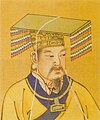 |
Phoenix crown | 
|
| Tongtianguan |  |
Huasheng | 
|
| Pibian | 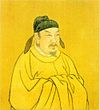 |
Bian | 
|
| Jinxianguan | Hairpin | 
| |
| Longguan | 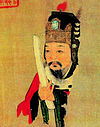 |
||
| Putou (襆頭), lit. "head cover' or "head wrap". An early form of informal headwear dates back as early as Jin Dynasty that later developed into several variations for wear in different occasions. | 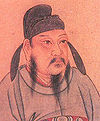 |
||
| Zhangokfutou (展角幞頭), lit. "Spread-Horn Head Cover", designed by the founder of Song Dynasty, with elongated horns on both sides in order to keep the distance between his officials so they couldn't whisper to each other during court assemblies. It was also later adapted by the Ming Dynasty, authorized for court wear. |  |
||
| Zhan Chi Fu Tou (展翅幞頭), lit. "Spread-Wing Head Cover", more commonly known by its nickname Wu Sha Mao (烏紗帽), lit. 'Black-Cloth Hat', was the standard headwear of officials during the Ming Dynasty. The term 'Wu Sha Mao' is still frequently used in modern Chinese slang when referring to a government position. |  |
||
| Yishanguan (翼善冠), lit. "Winged Crown of Philanthropy", worn by emperors and princes of the Ming Dynasty, as well as kings of many of its tributaries such as Korea and Ryukyu. The version worn by emperors was elaborately decorated with jewels and dragons; while the others looked basically like Wu Sha Mao only with wings folded upwards. | 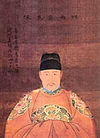 |
||
| Pashou |  |
||
| Patou |  |
||
| Zhuzi jin |  |
||
| Zhouzi jin |  |
||
| Zhuangzi jin |  |
||
| Fujin |  |
||
| Li | 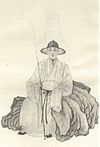 |
||
| Zi | 
| ||
| Wangjing | 
|
Style

Han Chinese clothing had changed and evolved with the fashion of the days since its commonly assumed beginnings in the Shang dynasty. Many of the earlier designs are more gender-neutral and simple in cuttings. Later garments incorporate multiple pieces with men commonly wearing pants and women commonly wearing skirts. Clothing for women usually accentuates the body's natural curves through wrapping of upper garment lapels or binding with sashes at the waist.
Informal wear
Types include tops (yi) and bottoms (divided further into pants and skirts for both genders, with terminologies chang or qun), and one-piece robes that wrap around the body once or several times (shenyi).
- Zhongyi (中衣) or zhongdan (中單): inner garments, mostly white cotton or silk
- Shanqun (衫裙): a short coat with a long skirt
- Ruqun (襦裙): a top garment with a separate lower garment or skirt
- Kuzhe (褲褶): a short coat with trousers
- Zhiduo/zhishen (直裰/直身): a Ming Dynasty style robe, similar to a zhiju shenyi but with vents at the side and 'stitched sleeves' (i.e. the sleeve cuff is closed save a small opening for the hand to go through)
- Daopao/Fusha (道袍/彿裟): Taoist/Buddhist priests' full dress ceremonial robes. Note: Daopao doesn't necessarily means Taoist's robe, it actually is a style of robe for scholars. And the Taoist version of Daopao is called De Luo (得罗), and Buddhist version is called Hai Qing (海青).

A typical set of Hanfu can consist of two or three layers. The first layer of clothing is mostly the zhongyi (中衣) which is typically the inner garment much like a Western T-shirt and pants. The next layer is the main layer of clothing which is mostly closed at the front. There can be an optional third layer which is often an overcoat called a zhaoshan which is open at the front. More complicated sets of Hanfu can have many more layers.
For footwear, white socks and black cloth shoes (with white soles) are the norm, but in the past, shoes may have a front face panel attached to the tip of the shoes. Daoists, Buddhists and Confucians may have white stripe chevrons.
Semi-formal wear
A piece of Hanfu can be "made semi-formal" by the addition of the following appropriate items:
- Chang (裳): a pleated skirt
- Bixi (蔽膝): long front cloth panel attached from the waist belt
- Zhaoshan (罩衫): long open fronted coat
- Guan (冠) or any formal hats
Generally, this form of wear is suitable for meeting guests or going to meetings and other special cultural days. This form of dress is often worn by the nobility or the upper-class as they are often expensive pieces of clothing, usually made of silks and damasks. The coat sleeves are often deeper than the shenyi to create a more voluminous appearance.
Formal wear

In addition to informal and semi-formal wear, there is a form of dress that is worn only at confucian rituals (like important sacrifices or religious activities) or by special people who are entitled to wear them (such as officials and emperors). Formal wear are usually long wear with long sleeves except Xuanduan.
Formal garments may include:
- Xuanduan (玄端): a very formal dark robe; equivalent to the Western white tie
- Shenyi (深衣): a long full body garment
- Yuanlingshan (圓領衫), lanshan (襴衫) or panlingpao (盤領袍): closed, round-collared robe; mostly used for official or academical dress
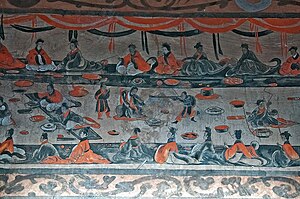
| Style | Views | |||
|---|---|---|---|---|
| Xuanduan |  |
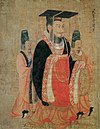 |
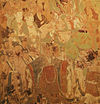
| |
| Shenyi | 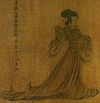 |
 |
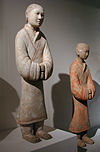 |
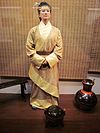
|
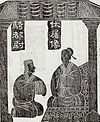 |
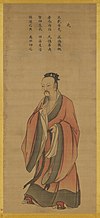 |

| ||
| Yuanlingshan | 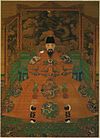 |
 |
 |
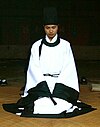
|
The most formal Hanfu that a civilian can wear is the xuanduan (sometimes called yuanduan 元端[14]), which consists of a black or dark blue top garment that runs to the knees with long sleeve (often with white piping), a bottom red chang, a red bixi (which can have a motif and/or be edged in black), an optional white belt with two white streamers hanging from the side or slightly to the front called peishou (佩綬), and a long black guan. Additionally, wearers may carry a long jade gui (圭) or wooden hu (笏) tablet (used when greeting royalty). This form of dress is mostly used in sacrificial ceremonies such as Ji Tian (祭天) and Ji Zu (祭祖), etc., but is also appropriate for state occasions. The xuanduan is basically a simplified version of full court dress of the officials and the nobility.
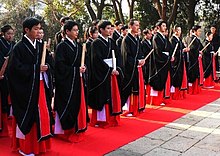
Those in the religious orders wear a plain middle layer garment followed by a highly decorated cloak or coat. Taoists have a 'scarlet gown' (絳袍)[15] which is made of a large cloak sewn at the hem to create very long deep sleeves used in very formal rituals. They are often scarlet or crimson in color with wide edging and embroidered with intricate symbols and motifs such as the eight trigrams and the yin and yang Taiji symbol. Buddhist have a cloak with gold lines on a scarlet background creating a brickwork pattern which is wrapped around over the left shoulder and secured at the right side of the body with cords. There may be further decorations, especially for high priests.[16]
Those in academia or officialdom have distinctive gowns (known as changfu 常服 in court dress terms). This varies over the ages but they are typically round collared gowns closed at the front. The most distinct feature is the headwear which has 'wings' attached. Only those who passed the civil examinations are entitled to wear them, but a variation of it can be worn by ordinary scholars and laymen and even for a groom at a wedding (but with no hat).
Court dress
-
The Emperor's Mianfu (Sun Quan as Emperor, Three Kingdoms period)
-
The Emperor in his court (Emperor Wu of Northern Zhou)
-
The Empress's Diyi (Empress Li Fengniang, Song Dynasty)
-
Diyi (Empress Wu, Song Dynasty)
-
Princess of Cao Guo (曹國公主, personal name Zhu Fonv (朱佛女), sister of Hongwu Emperor, Ming Dynasty)
Seated portrait wearing Da Shan Xia Pei (大衫霞帔, lit. "The Grand Dress of Draping Radiance") -
Emperor's Yellow Pao (Yongle Emperor, Ming Dynasty)
-
Gongfu (Emperor Zhenzong, Song Dynasty)
-
Highest rank official's Mang Pao (蟒袍, lit. "The Python Robe". The right to wear such dress was seen as a special honour that emperors bestowed on officials who had done great deeds for the empire so they earned the privilege to wear the 'python' - named so because only royals could wear dragons [which are five-clawed], thus the modified 'pythons' [which look basically like dragons only with four claws] for prestigious officials. Ming Dynasty)
-
Official's Changfu (Ming Dynasty)
-
Lower rank official's Changfu (Ming Dynasty)
-
Official dressed with different colored Changfu. (Ming Dynasty)
-
Court dress in a court assembly during the Wanli Era (Ming Dynasty)
Court dress is the dress worn at very formal occasions and ceremonies that are in the presence of a monarch (such as an enthronement ceremony). The entire ensemble of clothing can consist of many complex layers and look very elaborate. Court dress is similar to the xuanduan in components but have additional adornments and elaborate headwear. They are often brightly colored with vermillion and blue. There are various versions of court dress that are worn for certain occasions.
Court dress refers to:

| Romanization | Hanzi | Definition |
|---|---|---|
| Mianfu | 冕服 | religious court dress of emperor, officials or nobility |
| Bianfu | 弁服 | ceremonial military dress of emperor, officials or nobility |
| Chaofu | 朝服 | a red ceremonial court dress of emperor, officials or nobility |
| Gongfu | 公服 | formal court dress according to ranks |
| Changfu | 常服 | everyday court dress |
The practical use of court dress is now obsolete in the modern age since there is no reigning monarch in China anymore.
Specific styles
Historically, Han Chinese clothing has influenced many of its neighbouring cultural costumes, such as Japanese kimono, yukata,[17][18] and the Vietnamese Áo giao lĩnh.[19][20] Elements of Han Chinese clothing have also been influenced by neighbouring cultural costumes, especially by the nomadic peoples to the north, and Central Asian cultures to the west by way of the Silk Road.[21][22]
Tang dynasty

The Tang dynasty represents a golden age in China's history, where the arts, sciences and economy were thriving. Female dress and personal adornments in particular reflected the new visions of this era, which saw unprecedented trade and interaction with cultures and philosophies alien to Chinese borders. Although it still continues the clothing of its predecessors such as Han and Sui dynasties, fashion during the Tang was also influenced by its cosmopolitan culture and arts. Where previously Chinese women had been restricted by the old Confucian code to closely wrapped, concealing outfits, female dress in the Tang Dynasty gradually became more relaxed, less constricting and even more revealing.[23] The Tang Dynasty also saw the ready acceptance and syncretisation with Chinese practice, of elements of foreign culture by the Han Chinese. The foreign influences prevalent during Tang China included cultures from Gandhara, Turkistan, Persia and Greece. The stylistic influences of these cultures were fused into Tang-style clothing without any one particular culture having especial prominence.[24]
Song and Yuan dynasty

Some features of Tang Clothing carried into the Song Dynasty Such as court customs. Song court customs often use red color for their garments with black leather shoe and hats. Collar edges and sleeve edges of all clothes that have been excavated were decorated with laces or embroidered patterns. Such clothes were decorated with patterns of peony, camellia, plum blossom, and lily, etc. Song Empress often had three to five distinctive jewelry-like marks on their face (two side of the cheek, other two next to the eyebrows and one on the forehead). Although some of Song clothing have similarities with previous dynasties, some unique characteristics separate it from the rest. Many of Song Clothing goes into Yuan and Ming.[25] One of the common clothing style for the woman in Song Dynasty is Beizi(褙子), which were usually regard as shirt or jacket and could be matched with Ru or Ku. There are two size of Beizi: short one is crown rump length and long one means the length cover to knees.[26]
Ming dynasty
-
Female's Ao Qun (襖裙, lit. coat-and-skirt), historical artifact kept in Kong Family Mansion.
-
Commoner's clothing
-
Nicolas Trigault, a Flemish Jesuit in Ming style Confucian-scholar costume (Rufu 儒服).
Drawing by Peter Paul Rubens, 1617. -
A portrait painting of Nicolas Trigault believed to be wearing the same costume as shown in the drawing. By Rubens' workshop.
According to the Veritable Records of Hongwu Emperor (太祖實錄, a detailed official account written by court historians recording the daily activities of Hongwu Emperor during his reign.), shortly after the founding of Ming dynasty, "on the Renzi day in the second month of the first year of Hongwu era (Feb 29th, 1368 CE), Hongwu emperor decreed that all fashions of clothing and headwear shall be restored to the standard of Tang, all citizens shall gather their hairs on top of their heads, and officials shall wear the Wu Sha Mao (Black-cloth Hats), round-collar robes, belts, and black boots." ("洪武元年二月壬子...至是,悉命復衣冠如唐制,士民皆束髮於頂,官則烏紗帽,圓領袍,束帶,黑靴。") This attempt to restore the entire clothing system back to the way it was during Tang Dynasty was a gesture from the founding emperor that signified the restoration of Han tradition and cultural identity after defeating the Yuan dynasty. However, fashionable Mongol attires, items and hats were still sometimes worn by early Ming royalties such as Emperors Hongwu and Zhengde.[22][27]
The Ming dynasty also brought many changes to its clothing, as many dynasties do. They implemented metal buttons and the collar changed from the symmetrical type of the Song Dynasty (960-1279) to the main circular type. Compared with the costume of the Tang Dynasty (618-907), the proportion of the upper outer garment to lower skirt in the Ming Dynasty was significantly inverted. Since the upper outer garment was shorter and the lower garment was longer, the jacket gradually became longer to shorten the length of the exposed skirt. Young ladies in the mid Ming Dynasty usually preferred to dress in these waistcoats. The waistcoats in the Qing Dynasty were transformed from those of the Yuan Dynasty. During the Ming Dynasty, Confucian codes and ideals were popularized and it had a significant effect on clothing.[28]
| Official Dress Codes of the Ming Dynasty | |||||||
|---|---|---|---|---|---|---|---|
| Precedence | Rank | Robe Color | Animal on Patch (Civil) |
Animal on Patch (Military) |
Exemplified Positions (Not All-Inclusive) | ||
正一品 |
Regional Commander 都督 | ||||||
從一品 |
Regional Executive Officer 都督同知 | ||||||
正二品 |
Secretary of Defense 兵部尚書 | ||||||
從二品 |
Provincial Deputy Commander 都指揮同知 | ||||||
正三品 |
Deputy Secretary of Labor 工部侍郎 | ||||||
從三品 |
Minister of Salt Supply 都轉鹽運使 | ||||||
正四品 |
Minister of Foreign Affairs 鴻臚寺卿 | ||||||
從四品 |
Governor's Junior Assistant 參議 | ||||||
正五品 |
Grand Secretary of the Cabinet 内閣大學士 | ||||||
從五品 |
Deputy Manager of the Department of Justice 刑部員外郎 | ||||||
正六品 |
Minister of Buddhist Affairs 僧錄司善世 | ||||||
從六品 |
Deputy Manager of Minority Affairs 安撫司副使 | ||||||
正七品 |
Investigating Censor 監察御史 | ||||||
從七品 |
Deputy Ambassador 行人司左司副 | ||||||
正八品 |
Deputy County Administrator 縣丞 | ||||||
從八品 |
Supervisor at the Ministry of Royal Food Service 光祿寺監事 | ||||||
正九品 |
(not seahorse) |
Chief Officer at the Headquarter of Official Travels 會同館大使 | |||||
從九品 |
Marshal 巡檢 | ||||||
Qing dynasty


During the Qing dynasty, Manchu style clothing was only required for scholar-official elite such as the Eight Banners members and Han men serving as government officials.
When the Manchurians established the Qing dynasty, the authorities issued decrees having Han Chinese men to wear Manchurian attire and shave their hair into pigtails. The resistances against the hair shaving policy were suppressed.[29] Some Han civilian men also voluntarily adopted Manchu clothing like Changshan on their own free will. By the late Qing, not only officials and scholars, but a great many commoners as well, started to wear Manchu attire.[30][1] As a result, Ming dynasty style clothing was even retained in some places in China during the Xinhai Revolution.[31]
Throughout the Qing dynasty, Han women continued to wear clothing from Ming dynasty.[32] Neither Taoist priests nor Buddhist monks were required to wear the queue by the Qing; they continued to wear their traditional hairstyles, completely shaved heads for Buddhist monks, and long hair in the traditional Chinese topknot for Taoist priests.[33][34][35][36][37][38][39][40][41][42]
It was Han Chinese defectors who carried out massacres against people refusing to wear the queue. Li Chengdong, a Han Chinese general who had served the Ming but defected to the Qing,[43] ordered troops to carry out three separate massacres in the city of Jiading within a month, resulting in tens of thousands of deaths. The third massacre left few survivors.[44] The three massacres at Jiading District are some of the most infamous, with estimated death tolls in the tens or even hundreds of thousands.[45] Jiangyin also held out against about 10,000 Qing troops for 83 days. When the city wall was finally breached on October 9, 1645, the Qing army, led by the Han Chinese Ming defector Liu Liangzuo (劉良佐), who had been ordered to "fill the city with corpses before you sheathe your swords," massacred the entire population, killing between 74,000 and 100,000 people.[46]
Han Chinese soldiers in 1645 under Han General Hong Chengchou forced the queue on the people of Jiangnan while Han people were initially paid silver to wear the queue in Fuzhou when it was first implemented.[13][47]
-
Han female custom in Qing dynasty (1)
-
Han female custom in Qing dynasty (2)
-
Children in Qing dynasty
-
Taoist Clothing in Qing dynasty
Republic of China and modern China

During the Republic of China period, the styles and forms of traditional Qing costumes gradually changed, influenced by European and American fashion culture. Men wore Sun Yat-sen uniforms, western-style cloths, leather shoes and bowler hats as well as long robes, mandarin jackets, cotton cloth shoes and skullcaps; women wore cheong-sams and western style skirts.[48]
-
Yuan Shikai
-
An official of the Republic of China from Fujian
-
A graduate from Yanjing University in 1930
Gallery
-
Detail of a lacquerware painting from the Ching-mên Tomb (Chinese: 荊門楚墓; pinyin: Jīng mén chǔ mù) of the State of Ch'u (704–223 BC)
-
A female servant and male advisor in Chinese silk robes, ceramic figurines from the Western Han Period (202 BCE – 9 CE)
-
A Han Dynasty (202 BCE – 220 CE) pottery statuette of a female dancer
-
A Han dynasty fresco of a man in blue hunting dress
-
A Han dynasty fresco of a horseman in red hunting dress
-
A late Western Han (202 BC – 9 AD) painting from a tomb of Dongping County, Shandong province, showing women and men wearing Hanfu
-
A Western Han (202 BC – 9 AD) fresco depicting Confucius and Laozi, from a tomb of Dongping County, Shandong province, China
-
A man dressing in the Han dynasty style Shên-i
-
Fresco of a Western Han dynasty woman
-
Lively musicians playing a bamboo flute and a plucked instrument, Chinese ceramic statues from the Eastern Han period (25-220 AD), Shanghai Museum
-
A Chinese ceramic statue of a woman holding a bronze mirror, Eastern Han period (25-220 AD), Sichuan Provincial Museum, Chengdu
-
Mural from the Dahuting Tomb (Chinese: 打虎亭汉墓, Pinyin: Dahuting Han mu) of the late Eastern Han Dynasty (25-220 AD), located in Zhengzhou, Henan province, China
-
Mural from the Dahuting Tomb (Chinese: 打虎亭汉墓, Pinyin: Dahuting Han mu) of the late Eastern Han Dynasty (25-220 AD), located in Zhengzhou, Henan province, China, was excavated in 1960-1961 and contains vault-arched burial chambers decorated with murals showing scenes of daily life.
-
An Eastern Han lacquerware basket from the Lelang Commandery (modern North Korea) showing people wearing Hanfu robes, 108 BC - 133 AD, National Museum of Seoul
-
Painted lacquerware dish from the tomb of Zhu Ran (182-249 AD) in Anhui province, showing figures wearing Hanfu, Eastern Wu period
-
"Carpe diem": a mural painting showing the leisurely life scene, from a tomb in Chiu-ch'üan, Later Liang - Northern Liang
-
A man wearing Hanfu robes and a woman dressing in Tsa-chü-ch'ui-shao-fu, from a lacquerware painting over wood, Northern Wei period, 5th century AD
-
Male figure wearing Hanfu robes, from a lacquerware painting over wood, Northern Wei period, 5th century AD
-
Admonitions of the Court Instructress (detail) by Ku K'ai-chih
-
Admonitions of the Court Instructress (detail) by Ku K'ai-chih
-
Admonitions of the Court Instructress (detail) by Ku K'ai-chih
-
Duke Yi of Wey (衞懿公) from Wise and Benevolent Women by Ku K'ai-chih
-
Yuanlingshan robes of a Tang emperor Li Yuan
-
Court ladies of the Tang from Li Xianhui's tomb, Qianling Mausoleum, dated 706.
-
A painting of Tang Dynasty women playing with a dog, by artist Zhou Fang, 8th century.
-
Tang Dynasty Styled Hanfu
-
Buddhist donors of late T'ang dynasty.
-
A lady playing the pipa, T'ang dynasty.
-
A noble lady from the painting Bodhisattva Who Leads the Way, Five Dynasties and Ten Kingdoms.
-
Buddhist donatress Chang, Five Dynasties and Ten Kingdoms.
-
Pao-shan tomb wall-painting of Liao dynasty.
-
A Buddhist donor from early Northern Sung dynasty.
-
A male Buddhist donor from early Northern Sung dynasty.
-
A Sung dynasty mural reflecting a scene of the daily life of the occupant, found in a tomb unearthed in Tengfeng city.
-
A Song Dynasty empress, wife of Emperor Zhenzong of Song
-
Imperial Portrait of the empress and wife to Emperor Qinzong of (1100–1161) of the Song Dynasty in China.
-
A female figure from Vimalakirti and the Doctrine of Nonduality, Yüen dynasty.
-
A Ming Dynasty portrait of an Empress
-
Matteo Ricci and Xu Guangqi dressed in Ming Dynasty Hanfu.
-
Taoist priest in red colored gown
-
A 1940s embroidered Han infant hat (繡帽; xiùmào) with double tigers, in the collection of The Children’s Museum of Indianapolis.
Gallery of Classic Han Clothing in Modern Times
-
Aoqun (袄裙)
-
Banbi (半臂)
-
Bijia (比甲)
-
Modern Hanfu
-
Jess Sum at 2005 Hong Kong Flower Show
-
Coming of age ritual for a Chinese girl (笄禮)
-
Daopao (道袍)
-
Panling Lanshan (盤領襴衫)
-
Shenyi (深衣)
-
Zhiduo (直裰)
See also
Notes and references
- ^ a b Twitchett, Denis; Fairbank, John K. (2008) Cambridge History of China Volume 9 Part 1 The Ch'ing Empire to 1800, p87-88
- ^ 楊, 娜 (2016). 《漢服歸來》. 中國人民大學出版社. ISBN 978-7-300-23020-7.
- ^ a b Sandra Lee Evenson (30 October 2014). "Hanfu Chinese robes". In Annette Lynch; Mitchell D. Strauss (eds.). Ethnic Dress in the United States A Cultural Encyclopedia. Rowman & Littlefield Publishers. pp. 135–136. ISBN 978-0-7591-2150-8.
Chinese hanfu robes are full-length wrapped garments with bell-shaped sleeves extending over the hand. The front left opening is extended to a triangle shape....When wrapped, the contrast banding creates a dramatic play of line and color. Both men and women wear the hanfu; however, the overlap on the men's style is less extensive. In the Disney film Mulan, the title character wears a 'hanfu' to visit the matchmaker. History The term "hanfu" means "dress of the Han people." It is based on the two-piece, fitted shenyi of the Warring States period (475-221 BCE). ....By the Han dynasty (206 BCE-220 CE), the one-piece version emerged as a long voluminous linen or silk robe in vivid, contrasting primary colors. Manchu people from the northeast founded the Qing dyansty (1616-1911 CE). ...To expunge the Han identity, Qing rulers prohibited Han national dress and require them to wear garments in the Manchu tradition. Han resistance was so severe that the policies were modified. Men, government officials, Confucian scholars, and prostitutes wore the Manchu style; women, errand boys, children, monks, and Taoists were free to wear Han styles. Han dress was also permitted for special occasions such as weddings and funerals. During the Republic of China period (1911-1949 CE), Euro-America lifestyles and products influenced Chinese dress, representing a shift from dynastic to popular rule.... After the revolution in 1949 and the founding of the People's Republic of China, both traditional dress and world dress were rejected in favor of Mao suits and boxy cotton jackets and pants for bot men and women. Communist leadership discouraged reference to historical class hierarchies and modern capitalistic values. As a result, traditional Han dress was relegated to ceremonial use. With the liberalization of the Chinese economy, interest in national dress prompted a search for popular, authentic, and intrinsically Chinese styles. ... Because of its proportions, the hanfu is impractical for everyday dress, but is worn in China for Mid-Autumn Festival and for a new created coming-of-age ritual. Some favor the hanfu as a prototype for China's acaemia regalia. On the other hand, the hanfu resembles the Japanese kimono and Korean hanbok, both based on Chinese robes. Some scholars note that this cultural authentication of styles blurs the geopolitical boundaries of what is authentically Han. Infusion of Chinese-American aesthetics and meanings may further complicate identifying an intrinsically Chinese national dress. Hanfu in the United States Han dress arrived in the United States with Chinese immigrants in the nineteenth century. Male laborers tended toward Manchu jackets and pants for work on the pineapple and sugarcane plantations of Hawi'i, in the gold fields of the American West (1848-1855 CE), and on the transcontinental railroad (1863-1869 CE). Over time, their families joined them, bringing traditions such as ceremonial dress. In the United States, the hanfu is sorn as ethnic dress for special occasions through out the life cycle. Women's hanfu are billowing and fluid, with extended sleeves, trailing ribbons, and swaying dangles. Accessories range from the very traditional to the fashion forward, similar to the trending of other wedding dresses in America. Men's styles are more restrained, but equally elegant. Influence and Impact Euro-Americans often identify the hanfu as traditional Chinese dress, inspiring Seventh Avenue, Hollywood, and individuals alike. In addition, when times change, dress is often the stage where the negotiation of cultural values play out. The hanfu has been that stage, both historically and in the twenty-first century. The hanfu is also used as costuming in cosplay, where tradition and fantasy combine.
- ^ 《漢書》云:『後數來朝賀,樂漢衣服制度。』
- ^ 李冬青; 刘涛 (2014). "汉服的文化意義及傳承方式研究". 遼寧絲綢. 2014年第2期: 18–20.
- ^ 樊綽; 趙吕甫校释 (1985). 《云南志校释》 (in Chinese). 中国社会科学出版社. p. 143页.
「裳人,本漢人也。部落在鐵橋北,不知遷徙年月。初襲漢服,後稍参諸戎風俗,迄今但朝霞纏頭,其余無異。」
- ^ 《宋史》:“吾家世為王民,自金人犯邊,吾兄弟不能以死報國,避難入關,今為曦所逐,吾不忍棄漢衣冠,願死於此,為趙氏鬼。”
- ^ 《續明紀事本末》|publisher=臺灣大通書局|year=1957|page=214|language=zh|quote=「(金)聲桓預作數十棺,全家漢服坐其中,自焚死。」|author=倪在田}}
- ^ 华梅《汉服堪当中国人的国服吗?》,〈人民日报海外版〉,2007-06-14
- ^ a b ""汉服运动":互联网时代的种族性民族主义--《中国青年政治学院学报》2009年04期". 2016-08-04. Retrieved 2005-09-01.
- ^ a b Kevin Carrico, A State of Warring Styles
- ^ 羅, 雪揮 (2005-09-05). "《「漢服」先鋒》". 《中國新聞周刊》.[permanent dead link]
- ^ a b Michael R. Godley, "The End of the Queue:Hair as Symbol in Chinese History"
- ^ Xu, Zhongguo Gudai Lisu Cidian, p. 7.
- ^ Daoist Headdresses and Dress - Scarlet Robe
- ^ High Priest of the Shaolin Monastery Archived 2008-02-21 at the Wayback Machine
- ^ Stevens, Rebecca (1996). The kimono inspiration: art and art-to-wear in America. Pomegranate. pp. 131–142. ISBN 0-87654-598-3.
- ^ Dalby, Liza (2001). Kimono: Fashioning Culture. Washington, USA: University of Washington Press. pp. 25–32. ISBN 0-295-98155-5.
- ^ 《大南實錄・正編・第一紀・世祖實錄》,越南阮朝,國史館
- ^ 《大南实录・正编・第一纪・卷五十四・嘉隆十五年七月条》,越南阮朝,國史館
- ^ Finnane, Antonia (2008), Changing clothes in China: fashion, history, nation, Columbia University Press, pp. 44–46, ISBN 0-231-14350-8
- ^ a b http://www.bbc.co.uk/programmes/b06yglnh
- ^ Costume in the Tang Dynasty chinaculture.org retrieved 2010-01-07
- ^ Yoon, Ji-Won (2006). "Research of the Foreign Dancing Costumes: From Han to Sui-Tang Dynasty". 56. The Korean Society of Costume: 57–72.
{{cite journal}}: Cite journal requires|journal=(help) - ^ Costume in the Song Dynasty chinaculture.org retrieved 2010-01-07
- ^ <The History of Chinese Ancient Clothing>Author:Chou XiBao 2011-01-01
- ^ http://www.history.ubc.ca/sites/default/files/documents/readings/robinson_culture_courtiers_ch.8.pdf
- ^ Costume in the Ming Dynasty chinaculture.org retrieved 2010-01-07
- ^ 呤唎 (February 1985). 《太平天國革命親歷記》. 上海古籍出版社.
- ^ Edward J. M. Rhoads (2000). Manchus and Han: Ethnic Relations and Political Power in Late Qing and Early Republican China, 1861–1928. University of Washington Press. pp. 61–. ISBN 978-0-295-98040-9.
- ^ 魏千志《明清史概論》,中國社會科學出版社,1998年,第358-360頁
- ^ 周锡保. 《中国古代服饰史》. 中国戏剧出版社. 2002-01-01: 449. ISBN 9787104003595.
- ^ Edward J. M. Rhoads (2000). Manchus and Han: Ethnic Relations and Political Power in Late Qing and Early Republican China, 1861–1928. University of Washington Press. pp. 60–. ISBN 978-0-295-98040-9.
- ^ Gerolamo Emilio Gerini (1895). Chŭlăkantamangala: Or, The Tonsure Ceremony as Performed in Siam. Bangkok Times. pp. 11–.
- ^ The Museum Journal. The Museum. 1921. pp. 102–.
- ^ George Cockburn (1896). John Chinaman: His Ways and Notions. J. Gardner Hitt. pp. 86–.
- ^ Robert van Gulik (15 November 2010). Poets and Murder: A Judge Dee Mystery. University of Chicago Press. pp. 174–. ISBN 978-0-226-84896-9.
- ^ James William Buel (1883). Mysteries and Miseries of America's Great Cities: Embracing New York, Washington City, San Francisco, Salt Lake City, and New Orleans. A.L. Bancroft & Company. pp. 312–.
- ^ Justus Doolittle (1876). Social Life of the Chinese: With Some Account of Their Religious, Governmental, Educational, and Business Customs and Opinions. With Special But Not Exclusive Reference to Fuhchau. Harpers. pp. 241–.
- ^ Justus Doolittle, Social life of the Chinese : with some account of their religious, governmental, educational and business customs and opinions, with special but not exclusive reference to Fuhchau c
- ^ East Asian History. Institute of Advanced Studies, Australian National University. 1994. p. 63.
- ^ Michael R. Godley, The End of the Queue: Hair as Symbol in Chinese History
- ^ Faure (2007), p. 164.
- ^ Ebrey (1993)
- ^ Ebrey, Patricia (1993). Chinese Civilization: A Sourcebook. Simon and Schuster. p. 271.
- ^ Wakeman 1975b, p. 83.
- ^ Justus Doolittle (1876). Social Life of the Chinese: With Some Account of Their Religious, Governmental, Educational, and Business Customs and Opinions. With Special But Not Exclusive Reference to Fuhchau. Harpers. pp. 242–.
- ^ Mei Hua, Chinese Clothing, Cambridge University Press, 2010, pp. 133–134
Bibliography
- Zhou Xibao (1984), 【中國古代服飾史】 Zhongguo Gudai Fushi Shi (History of Ancient Chinese Costume), Beijing: Zhongguo Xiju.
- Zhou, Xun; Gao, Chunming; The Chinese Costumes Research Group (1984), 5000 Years of Chinese Costume, Hong Kong: The Commercial Press. ISBN 962-07-5021-7
- 許嘉璐 Xu Jialu (1991), 【中國古代禮俗辭典】 Zhongguo Gudai Lisu Cidian (Dictionary of Rituals and Customs of Ancient China).
- 沈從文 Shen Congwen (1999, 2006), 【中國古代服飾研究】 Zhongguo Gudai Fushi Yanjiu (Researches on Ancient Chinese Costumes), Shanghai: Shanghai Century Publishing Group. ISBN 7-80678-329-6
- 黃能馥, 陳娟娟 Huang Nengfu and Chen Juanjuan (1999), 【中華歷代服飾藝術】 Zhonghua Lidai Fushi Yishu (The Art of Chinese Clothing Through the Ages), Beijing.
- 華梅 Hua, Mei (2004), 【古代服飾】 Gudai Fushi (Ancient Costume), Beijing: Wenmu Chubanshe. ISBN 7-5010-1472-8
- Zhou, Xun; Gao, Chunming (1988). 5000 years of Chinese costumes. San Francisco: China Books & Periodicals. ISBN 9780835118224.
External links
 Media related to Hanfu at Wikimedia Commons
Media related to Hanfu at Wikimedia Commons

















![Highest rank official's Mang Pao (蟒袍, lit. "The Python Robe". The right to wear such dress was seen as a special honour that emperors bestowed on officials who had done great deeds for the empire so they earned the privilege to wear the 'python' - named so because only royals could wear dragons [which are five-clawed], thus the modified 'pythons' [which look basically like dragons only with four claws] for prestigious officials. Ming Dynasty)](http://upload.wikimedia.org/wikipedia/commons/thumb/4/4d/%E7%8E%8B%E9%8F%8A.jpg/121px-%E7%8E%8B%E9%8F%8A.jpg)






